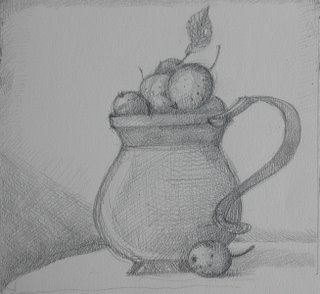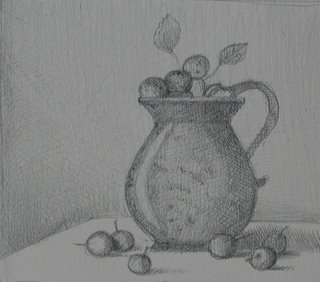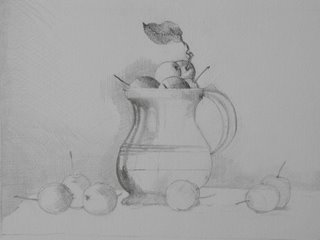Still-life and imagination
October 4th, 2006
I think that still-life would be of little interest as an art-form if it were a pure reflection of inanimate objects. And yet it is precisely the “still” aspect of this genre that makes it of special interest to painters. The artist has the time to study fine details, or subtleties of composition in a still-life that are more challenging when painting a portrait from life, or a cityscape on a crowded street.

Hanneke van Oosterhout was recently “trapped” in a smoky cafe for hours with nothing to do. Fortunately she had her sketch book with her and she made these two drawings from her imagination.
Something about these drawings pleased her. When she was able to return to her studio the next day, she attempted to construct a real still-life that combined aspects of the two drawings.

This still-life drawing is nice, but it lacks something that we can see in the imaginary drawings.
Comparing the real and imaginary drawings, we can easily see the important differences. The real still-life, like most of Hanneke’s still-life pictures, is a centered composition. It has a conventional feel of balance which is somewhat dull. The imaginary still-life drawings are both unbalanced, with the main weight of the objects skewed somewhat to the right side.
Another difference is evident in the perspective. The vessel in all three drawings is seen directly from the side. To achieve this constraint in the real still-life, the fruit on the table top is also seen from the side. But in the imaginary still-life, the table top and fruit are seen from a different perspective, from above. We seem to look down on the table top while looking at the vessel from the side. This merging of different perspective points lends an interesting quality to the imaginary drawings. When drawing more or less literally from a real still-life, this quality is lost.
Does the real still-life need to be drawn from only one viewpoint?
Are there other fundamental differences between real and imaginary drawings that I have missed?
October 4th, 2006 at 10:04 am
When you draw from your imagination, you really draw with your feelings, you are much more sensitive to what is right in your mind. When you look at real stuff, you just draw what is there, it may not be as beautiful. In your mind you have a natural feeling for beauty. That’s why I think you should set up a still-life and then look at it for some time and then go away and sit (maybe in a smoky cafe) and draw it from your mind. Then you can use that as a basis for your painting. Because then your are really giving back what you receive from nature.
October 4th, 2006 at 2:23 pm
I am struck by the beauty of the handles in the pictures drawn from imagination. The handle in the first picture is bold, in the second graceful. In comparison, the handle in third picture strikes me as dull.
October 4th, 2006 at 11:55 pm
I think they are all exceptional, but the third one has more of a graphic feel than the other two. Sometimes when things are less perfect they become naturally beautiful…
October 5th, 2006 at 10:31 pm
Hanneke,
a question about your earlier still lifes showing roses standing in water. Did you paint the water from your imagination?